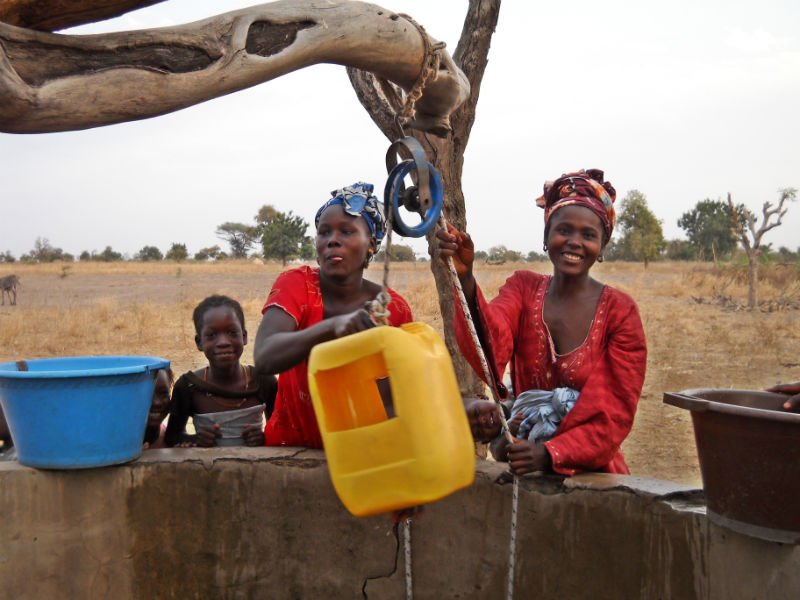Difference between revisions of "绳子与水桶"
| Line 31: | Line 31: | ||
可以自动清空的容器(或被称为mohte)可以用来替代水桶。这一装置由一个形似漏斗的皮制容器、组成。这样的容器通常能容纳100到150升水,能每分钟从最深9米处打水约130升。 | 可以自动清空的容器(或被称为mohte)可以用来替代水桶。这一装置由一个形似漏斗的皮制容器、组成。这样的容器通常能容纳100到150升水,能每分钟从最深9米处打水约130升。 | ||
| − | + | 绳桶提水装置也能改装成双桶,两桶上下交替进行。在这种情况下,拉绳的动物在环形道上移动,借助中间的旋转杆、绳子和滑轮的作用,使水桶上下活动。每一个水桶能容纳最多70升的水。水桶底部有铰链翻片,起到阀门的作用。井中装有导杆,控制水桶的活动。在运作过程中,水桶自动装水和倒空。这一装置能从最深5米处每分钟提水约230升。 | |
====维护==== | ====维护==== | ||
Revision as of 05:37, 25 October 2015

这一装置主要与手工挖掘井工具一同使用。将桶系在绳子上降到水中。当桶碰到水的时候会下沉并装满水,再用绳子把它拉上来。绳子可以由手拉动,运用滑轮或绕在绞盘上。有时,畜力牵拉可与滑轮一同使用。改良的装置会将绳子绕过滑轮,再用两只水桶——绳子两端各系一只水桶。对于浅于10米深的水而言,可以使用带有软管的绞盘,软管从水桶底部连到井的出水口。然而, 即使是水井受到保护,这一装置的卫生情况较差。
适宜条件
| 优势 | 不足 |
|---|---|
| - 技术简易,造价与维护费用低廉 - 最深可在100米处运作 |
- 通过人力运作的绳桶提水装置每分钟仅能供水15升 - 动物全年都需要养护,甚至不用灌溉时也要养护 |
建造、运作与维护
深度范围:0–15米(或有时甚至更深)。
产水量:10米深时0.25 升/秒。
从地下打水最简易、廉价的的方法仍然是运用绳子和水桶在宽浅的井中提水。这类井最深能达100米,虽然少有超过45米深的。绳桶提水装置可以由人力或畜力驱动。人力绳桶装置通常每分钟能从10-15米深处提出10-15升水,而畜力装置每分钟能从15米深处提出150升水。在畜力驱动的绳桶提水装置中,系在桶上的绳子穿过滑轮固定在动物身上。为了将水提起,动物会从一个5-10度的斜土坡上往下赶。
可以自动清空的容器(或被称为mohte)可以用来替代水桶。这一装置由一个形似漏斗的皮制容器、组成。这样的容器通常能容纳100到150升水,能每分钟从最深9米处打水约130升。
绳桶提水装置也能改装成双桶,两桶上下交替进行。在这种情况下,拉绳的动物在环形道上移动,借助中间的旋转杆、绳子和滑轮的作用,使水桶上下活动。每一个水桶能容纳最多70升的水。水桶底部有铰链翻片,起到阀门的作用。井中装有导杆,控制水桶的活动。在运作过程中,水桶自动装水和倒空。这一装置能从最深5米处每分钟提水约230升。
维护
The bucket is lowered and raised by playing out and pulling in the rope, or by rotating the windlass. Care must be taken to prevent the rope or bucket from be- coming soiled. Preventive maintenance consists of greasing the bearings of the windlass or pulley. Small repairs are limited to patching holes in the bucket and hose, reconnecting the hinge of the bucket, and fixing the windlass bearings or handle. All small repairs can be done by local people, and with tools and materials available in the community or area. Major repairs and replacements mainly consist of replacing the bucket, hose, rope, or part or all of the windlass. Woven nylon ropes may last for two years, but twined nylon or sisal ropes last only a few months. A good-quality hose may last for over two years, and most buckets last a year (depending on the material and quality). When people use their own rope and bucket, no extra organization is required. For community wells, a community committee usually organizes the maintenance and cleaning of the well, maintenance of the windlass, etc. Most repairs can be paid with ad hoc fund-raising.
Brikke and Bredero, in their publication Linking technology choice with operation and maintenance in the context of community water supply and sanitation: A reference document for planners and project staff, recommend the following O&M activities in the chart below:
潜在问题
— Poor-quality rope deteriorates quickly (e.g. sisal rope lasts for only a few months);
— The bucket falls into the well ... to prevent this, communities can keep a spare bucket and fit the bucket into a protective cage;
— The hose breaks frequently in windlass-and-hose systems;
— Poor hygiene, especially when the rope or bucket touches users’ hands or the ground;
— Communal wells tend to become more contaminated than family-owned wells, and the latter should be promoted whenever possible;
— The rope-and-bucket system is only suitable for limited depths.
成本
From US$ 6 for a plastic bucket and 5 m of rope, to US$ 150 with a windlass, hose and closed superstructure, in Liberia (Milkov, 1987).
实地经验
Area of use: All over the world.
指南、视频与链接
- 3. REVIEW OF PUMPS AND WATER LIFTNG TECHNIQUES. FAO.
- HUMAN & ANIMAL POWERED WATER-LIFTING DEVICES FOR IRRIGATION (full PDF). Practical Action.
- Extensive manual on water lifting methods: WASH technology information package. UNICEF, 2010.
鸣谢
- Brikke, François, and Bredero, Maarten. Linking technology choice with operation and maintenance in the context of community water supply and sanitation: A reference document for planners and project staff or (alternative link). World Health Organization and IRC Water and Sanitation Centre. Geneva, Switzerland 2003.
- Human- & Animal-Powered Water Lifters for Irrigation. Practical Action.


